power steering Citroen DS3 2011 1.G Owner's Manual
[x] Cancel search | Manufacturer: CITROEN, Model Year: 2011, Model line: DS3, Model: Citroen DS3 2011 1.GPages: 324, PDF Size: 25.11 MB
Page 41 of 324
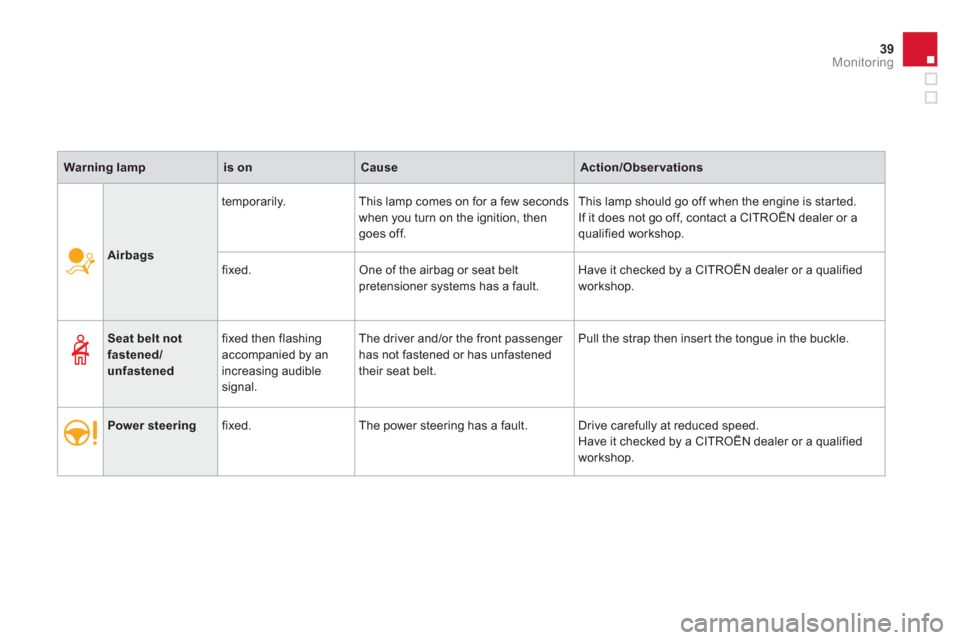
39Monitoring
Airbags
temporarily. This lamp comes on for a few seconds
when you turn on the ignition, then
goes off. This lamp should go off when the engine is star ted.
If it does not go off, contact a CITROËN dealer or a
qualified workshop.
fixed. One of the airbag or seat belt
pretensioner systems has a fault. Have it checked by a CITROËN dealer or a qualified
workshop.
Warning lamp
is on
Cause
Action/Observations
Seat belt not
fastened/
unfastened
fixed then flashing
accompanied by an
increasing audible
signal. The driver and/or the front passenger
has not fastened or has unfastened
their seat belt. Pull the strap then inser t the tongue in the buckle.
Power steering
fixed. The power steering has a fault. Drive carefully at reduced speed.
Have it checked by a CITROËN dealer or a qualified
workshop.
Page 124 of 324
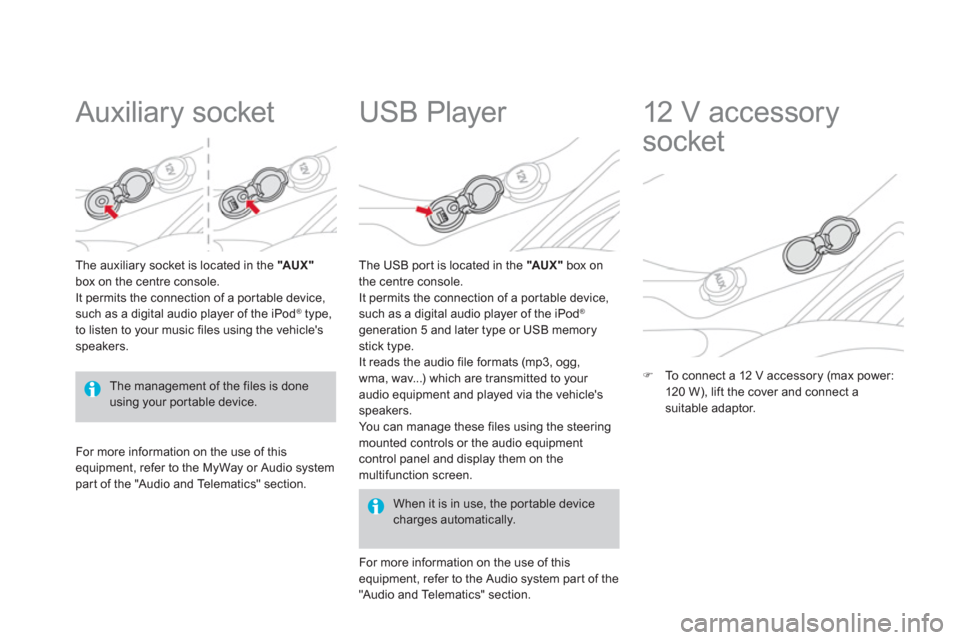
Auxiliary socket
The auxiliary socket is located in the " AUX "
box on the centre console.
It permits the connection of a por table device,
such as a digital audio player of the iPod
® type,
to listen to your music files using the vehicle's
speakers.
USB Player
For more information on the use of this
equipment, refer to the MyWay or Audio system
part of the "Audio and Telematics" section.
When it is in use, the por table device
charges automatically.
The USB por t is located in the "AU X "
box on
the centre console.
It permits the connection of a por table device,
such as a digital audio player of the iPod
®
generation 5 and later type or USB memory
stick type.
It reads the audio file formats (mp3, ogg,
wma, wav...) which are transmitted to your
audio equipment and played via the vehicle's
speakers.
You can manage these files using the steering
mounted controls or the audio equipment
control panel and display them on the
multifunction screen.
For more information on the use of this
equipment, refer to the Audio system par t of the
"Audio and Telematics" section.
12 V accessory
socket
�)
To connect a 12 V accessory (max power:
120 W), lift the cover and connect a
suitable adaptor. The management of the files is done
using your portable device.
Page 168 of 324
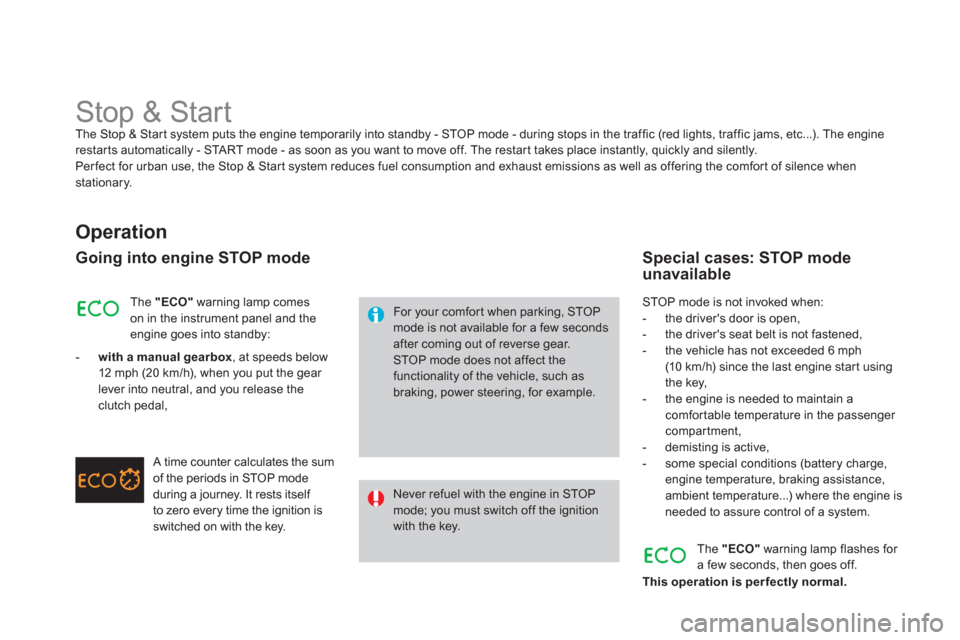
Stop & Start
The Stop & Start system puts the engine temporarily into standby - STOP mode - during stops in the traffic (red lights, traffic jams, etc...). The engine
restarts automatically - START mode - as soon as you want to move off. The restart takes place instantly, quickly and silently.
Per fect for urban use, the Stop & Start system reduces fuel consumption and exhaust emissions as well as offering the comfort of silence when
stationary.
Operation
Going into engine STOP mode
For your comfort when parking, STOP
mode is not available for a few seconds
after coming out of reverse gear.
STOP mode does not affect the
functionality of the vehicle, such as
braking, power steering, for example.
Never refuel with the engine in STOP
mode; you must switch off the ignition
with the key. The "ECO"
warning lamp comes
on in the instrument panel and the
engine goes into standby:
- with a manual gearbox
, at speeds below
12 mph (20 km/h), when you put the gear
lever into neutral, and you release the
clutch pedal,
A time counter calculates the sum
of the periods in STOP mode
during a journey. It rests itself
to zero every time the ignition is
switched on with the key. STOP mode is not invoked when:
- the driver's door is open,
- the driver's seat belt is not fastened,
- the vehicle has not exceeded 6 mph
(10 km/h) since the last engine star t using
the key,
- the engine is needed to maintain a
comfor table temperature in the passenger
compartment,
- demisting is active,
- some special conditions (battery charge,
engine temperature, braking assistance,
ambient temperature...) where the engine is
needed to assure control of a system.
Special cases: STOP mode
unavailable
The "ECO"
warning lamp flashes for
a few seconds, then goes off.
This operation is per fectly normal.
Page 216 of 324
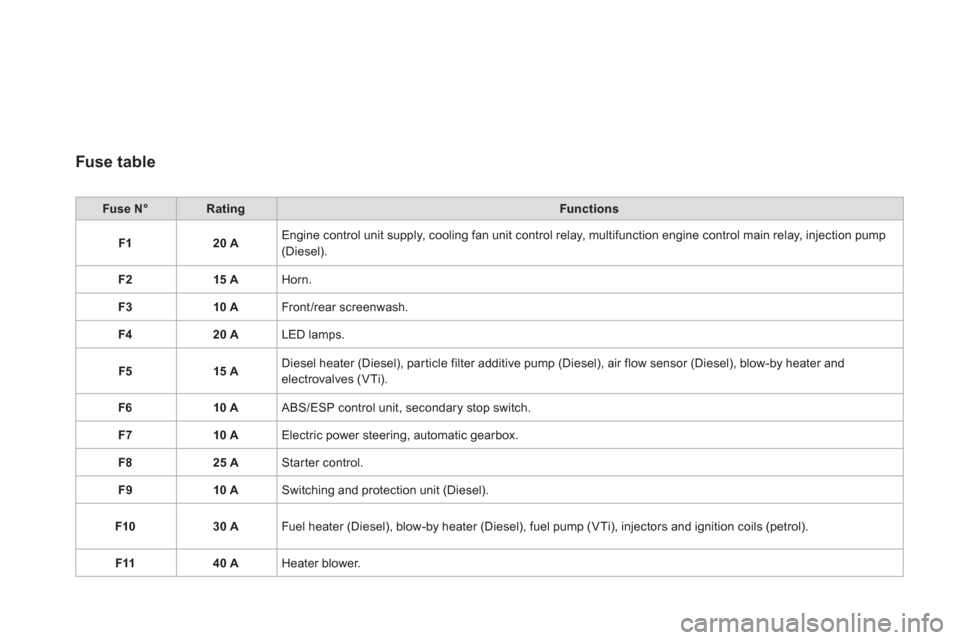
Fuse table
Fuse N°
Rating
Functions
F1
20 A
Engine control unit supply, cooling fan unit control relay, multifunction engine control main relay, injection pump
(Diesel).
F2
15 A
Horn.
F3
10 A
Front/rear screenwash.
F4
20 A
LED lamps.
F5
15 A
Diesel heater (Diesel), par ticle filter additive pump (Diesel), air flow sensor (Diesel), blow-by heater and
electrovalves (VTi).
F6
10 A
ABS/ESP control unit, secondary stop switch.
F7
10 A
Electric power steering, automatic gearbox.
F8
25 A
Starter control.
F9
10 A
Switching and protection unit (Diesel).
F10
30 A
Fuel heater (Diesel), blow-by heater (Diesel), fuel pump (VTi), injectors and ignition coils (petrol).
F11
40 A
Heater blower.
Page 223 of 324
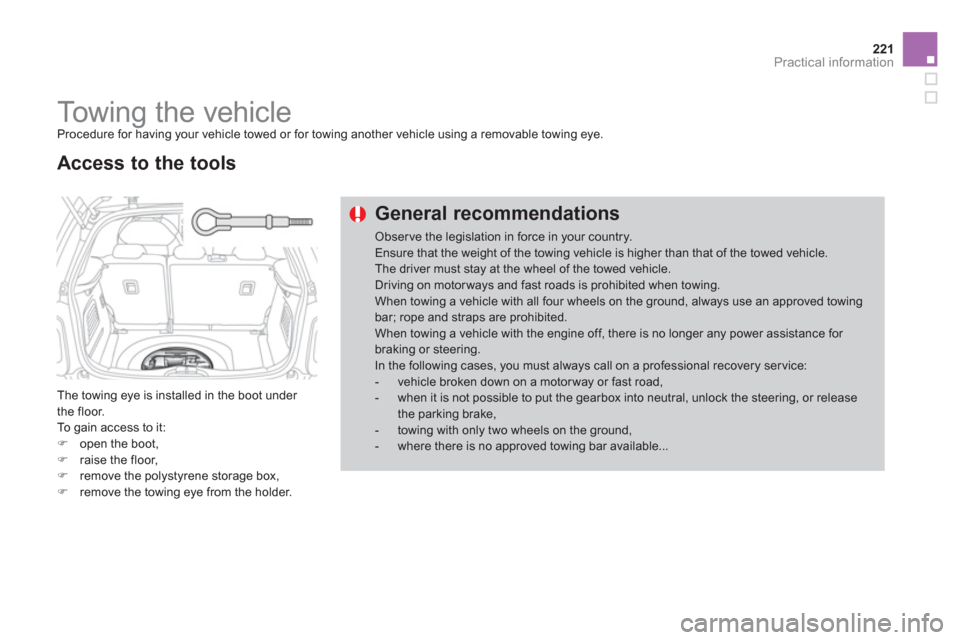
221Practical information
Towing the vehicle
Procedure for having your vehicle towed or for towing another vehicle using a removable towing eye.
The towing eye is installed in the boot under
the floor.
To gain access to it:
�)
open the boot,
�)
raise the floor,
�)
remove the polystyrene storage box,
�)
remove the towing eye from the holder.
Access to the tools
General recommendations
Obser ve the legislation in force in your country.
Ensure that the weight of the towing vehicle is higher than that of the towed vehicle.
The driver must stay at the wheel of the towed vehicle.
Driving on motor ways and fast roads is prohibited when towing.
When towing a vehicle with all four wheels on the ground, always use an approved towing
bar; rope and straps are prohibited.
When towing a vehicle with the engine off, there is no longer any power assistance for
braking or steering.
In the following cases, you must always call on a professional recovery ser vice:
- vehicle broken down on a motor way or fast road,
- when it is not possible to put the gearbox into neutral, unlock the steering, or release
the parking brake,
- towing with only two wheels on the ground,
- where there is no approved towing bar available...